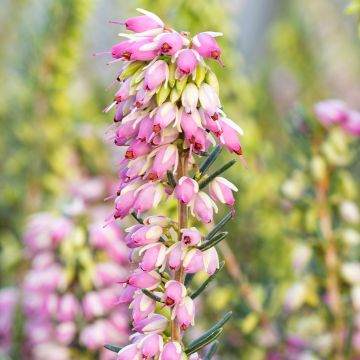

Choisya Aztec Gold - Mexican Orange Blossom


Choisya Aztec Gold - Mexican Orange Blossom


Choisya Aztec Gold - Mexican Orange Blossom
Choisya Aztec Gold - Mexican Orange Blossom
Choisya ternata x arizonica Aztec Gold (Hilgold)
Mexican Orange Blossom
Plant arrived half unpotted and top leaves damaged. Delivery seems to have gone wrong or the plants were poorly secured. Too bad.
Annie, 22/02/2025
Special offer!
Receive a €20 voucher for any order over €90 (excluding delivery costs, credit notes, and plastic-free options)!
1- Add your favorite plants to your cart.
2- Once you have reached €90, confirm your order (you can even choose the delivery date!).
3- As soon as your order is shipped, you will receive an email containing your voucher code, valid for 3 months (90 days).
Your voucher is unique and can only be used once, for any order with a minimum value of €20, excluding delivery costs.
Can be combined with other current offers, non-divisible and non-refundable.
Home or relay delivery (depending on size and destination)
Schedule delivery date,
and select date in basket
This plant carries a 24 months recovery warranty
More information
We guarantee the quality of our plants for a full growing cycle, and will replace at our expense any plant that fails to recover under normal climatic and planting conditions.
Would this plant suit my garden?
Set up your Plantfit profile →
Description
The Choisya 'Aztec Gold' is a recent variety of Mexican Orange, distinguished by its finely cut foliage that retains beautiful golden tones in all seasons and in all exposures. Elegant and luminous, it also offers white and delicately fragrant flowers in spring, often recurring at the end of summer, surrounded by the scent of orange blossom. The scent of the flowers, as well as the foliage when crushed, strongly resembles that of citrus trees, as this plant belongs to the same botanical family. Choisya are excellent bushes for our gardens, robust, resistant to drought, easy to grow in any well-drained soil and in all exposures in not-too-cold climates. This one, not very tall, beautifully structural, is a real treasure for the garden or terrace.
The Choisya 'Aztec Gold' is a descendant of the pretty variety 'Aztec Pearl', resulting from the cross-breeding between a Choisya ternata and a C. dumosa var. arizonica. It is an English horticultural creation dating from 2012, introduced by Hillier Nurseries. Its first parent, commonly called Mexican Orange, is widespread in the mountains of Mexico, but also in the southwest of the United States, from Arizona to Texas via New Mexico. The second is native to western North America, it is more compact, has feathery foliage, and is less hardy. All these plants belong to the citrus tree family. These bushes, whose foliage persists all year round, are accustomed to dry and hot climates.
'Aztec Gold' ('Hilgold)' is a small bush with growth of 1.20m (3.3ft) in all directions, on average at maturity. Its habit is bushy, rather rounded, and flexible. It bears opposite leaves, divided into 3 to 7 very narrow leaflets, with a slightly greenish yellow base, shiny, 6cm (2.4in) long and barely 1cm (0.4in) wide. They retain this pretty colour even in the shade and do not burn in the sun. When crushed, they emit a fresh, citrusy and spicy smell, reminiscent of both citrus leaf and green pepper. Flowering occurs in May-June, more or less early depending on the climate, and often again in the second part of summer. At the tips of the branches, clusters of slightly pinkish flower buds appear. They open into star-shaped flowers with 5 petals, 3 to 4cm (1.6in) in diameter. The delicately scented flowers are frequently visited by pollinating insects.
The Choisya 'Aztec Gold', particularly suitable for Mediterranean climates, adapts well north of the Loire in any light, loose, well-drained soil and in a warm, sunny location protected from cold winds. It can be planted near an entrance or a passage to enjoy its delicate fragrance as often as possible. It is also perfect on the terrace or balcony, planted in a large pot, regularly fertilized and watered. It can also be used in a small informal hedge, along with Escallonia, old roses, Caryopteris (Heavenly Blue, Sterling Silver), abelias (chinensis, grandiflora) or dwarf buddleias for example. Despite its exotic appearance and fragrance, it is capable, once established, of withstanding brief frosts of around -15°C (5°F), as well as long dry periods in summer.
Report an error about the product description
Choisya Aztec Gold - Mexican Orange Blossom in pictures


Plant habit
Flowering
Foliage
Botanical data
Choisya
ternata x arizonica
Aztec Gold (Hilgold)
Rutaceae
Mexican Orange Blossom
Cultivar or hybrid
Other Choisya - Mexican Orange Blossom
View all →Planting and care
The Mexican Orange Blossom is best planted in spring north of the Loire, and in early autumn in drier and warmer climates. It appreciates light, loose, well-drained soils. It tolerates the presence of chalk in the soil, but not in excess. Once established, after 2 or 3 years of cultivation, it can do without watering in summer, in all regions. Resistant to -15°C (5°F), it is quite sensitive during its early years, especially in heavy and damp soil: lighten your garden soil if necessary with the addition of river sand, gravel or pumice stone. Choose a warm location, in full sun in cold regions, but it's better in partial shade in very sunny and dry regions. If grown in shade, under trees, its habit will be more lax and its flowering less abundant. Plant it sheltered from cold winds, especially in our regions north of the Loire. In summer, during the first years, water regularly to help the bush establish itself.
Attention: The Mexican Orange Blossom is sensitive to attacks from Phytophthora, a fungus that attacks the collar of the plant when the soil is both warm and permanently moist; as a result, in hot regions, watering in summer should be spaced out to allow the soil to dry between waterings. The Mexican Orange Blossom is an easy-to-cultivate plant that tolerates competition from the roots of large trees. In a natural hedge, plant one bush every 60 to 80cm (31.5in). On a terrace, plant it in a container at least 30cm (11.8in) deep, fertilize it with a flowering shrub fertilizer, and let the substrate dry a little between waterings.
Planting period
Intended location
Care
-
, onOrder confirmed
Reply from on Promesse de fleurs
Similar products
Haven't found what you were looking for?
Hardiness is the lowest winter temperature a plant can endure without suffering serious damage or even dying. However, hardiness is affected by location (a sheltered area, such as a patio), protection (winter cover) and soil type (hardiness is improved by well-drained soil).

Photo Sharing Terms & Conditions
In order to encourage gardeners to interact and share their experiences, Promesse de fleurs offers various media enabling content to be uploaded onto its Site - in particular via the ‘Photo sharing’ module.
The User agrees to refrain from:
- Posting any content that is illegal, prejudicial, insulting, racist, inciteful to hatred, revisionist, contrary to public decency, that infringes on privacy or on the privacy rights of third parties, in particular the publicity rights of persons and goods, intellectual property rights, or the right to privacy.
- Submitting content on behalf of a third party;
- Impersonate the identity of a third party and/or publish any personal information about a third party;
In general, the User undertakes to refrain from any unethical behaviour.
All Content (in particular text, comments, files, images, photos, videos, creative works, etc.), which may be subject to property or intellectual property rights, image or other private rights, shall remain the property of the User, subject to the limited rights granted by the terms of the licence granted by Promesse de fleurs as stated below. Users are at liberty to publish or not to publish such Content on the Site, notably via the ‘Photo Sharing’ facility, and accept that this Content shall be made public and freely accessible, notably on the Internet.
Users further acknowledge, undertake to have ,and guarantee that they hold all necessary rights and permissions to publish such material on the Site, in particular with regard to the legislation in force pertaining to any privacy, property, intellectual property, image, or contractual rights, or rights of any other nature. By publishing such Content on the Site, Users acknowledge accepting full liability as publishers of the Content within the meaning of the law, and grant Promesse de fleurs, free of charge, an inclusive, worldwide licence for the said Content for the entire duration of its publication, including all reproduction, representation, up/downloading, displaying, performing, transmission, and storage rights.
Users also grant permission for their name to be linked to the Content and accept that this link may not always be made available.
By engaging in posting material, Users consent to their Content becoming automatically accessible on the Internet, in particular on other sites and/or blogs and/or web pages of the Promesse de fleurs site, including in particular social pages and the Promesse de fleurs catalogue.
Users may secure the removal of entrusted content free of charge by issuing a simple request via our contact form.
The flowering period indicated on our website applies to countries and regions located in USDA zone 8 (France, the United Kingdom, Ireland, the Netherlands, etc.)
It will vary according to where you live:
- In zones 9 to 10 (Italy, Spain, Greece, etc.), flowering will occur about 2 to 4 weeks earlier.
- In zones 6 to 7 (Germany, Poland, Slovenia, and lower mountainous regions), flowering will be delayed by 2 to 3 weeks.
- In zone 5 (Central Europe, Scandinavia), blooming will be delayed by 3 to 5 weeks.
In temperate climates, pruning of spring-flowering shrubs (forsythia, spireas, etc.) should be done just after flowering.
Pruning of summer-flowering shrubs (Indian Lilac, Perovskia, etc.) can be done in winter or spring.
In cold regions as well as with frost-sensitive plants, avoid pruning too early when severe frosts may still occur.
The planting period indicated on our website applies to countries and regions located in USDA zone 8 (France, United Kingdom, Ireland, Netherlands).
It will vary according to where you live:
- In Mediterranean zones (Marseille, Madrid, Milan, etc.), autumn and winter are the best planting periods.
- In continental zones (Strasbourg, Munich, Vienna, etc.), delay planting by 2 to 3 weeks in spring and bring it forward by 2 to 4 weeks in autumn.
- In mountainous regions (the Alps, Pyrenees, Carpathians, etc.), it is best to plant in late spring (May-June) or late summer (August-September).
The harvesting period indicated on our website applies to countries and regions in USDA zone 8 (France, England, Ireland, the Netherlands).
In colder areas (Scandinavia, Poland, Austria...) fruit and vegetable harvests are likely to be delayed by 3-4 weeks.
In warmer areas (Italy, Spain, Greece, etc.), harvesting will probably take place earlier, depending on weather conditions.
The sowing periods indicated on our website apply to countries and regions within USDA Zone 8 (France, UK, Ireland, Netherlands).
In colder areas (Scandinavia, Poland, Austria...), delay any outdoor sowing by 3-4 weeks, or sow under glass.
In warmer climes (Italy, Spain, Greece, etc.), bring outdoor sowing forward by a few weeks.


















































